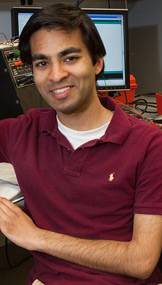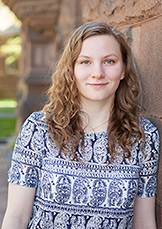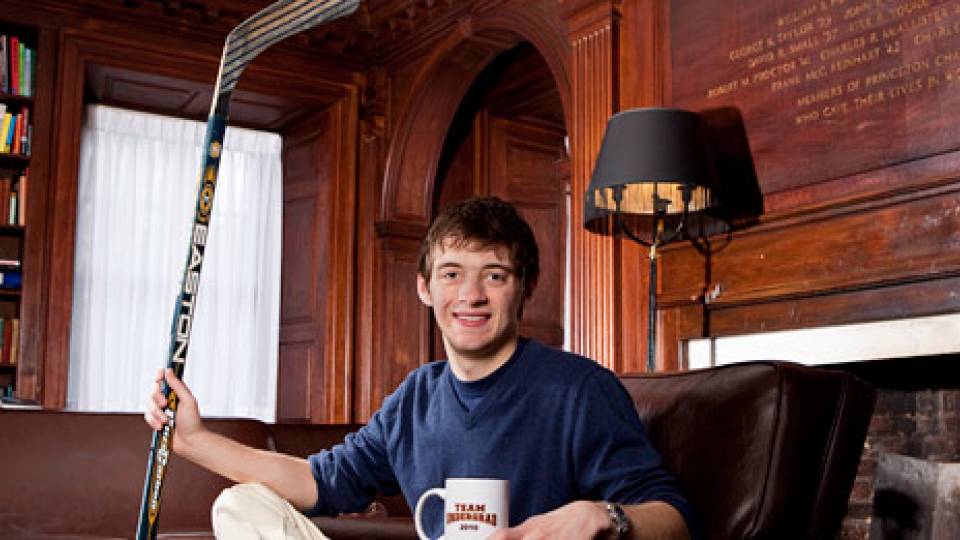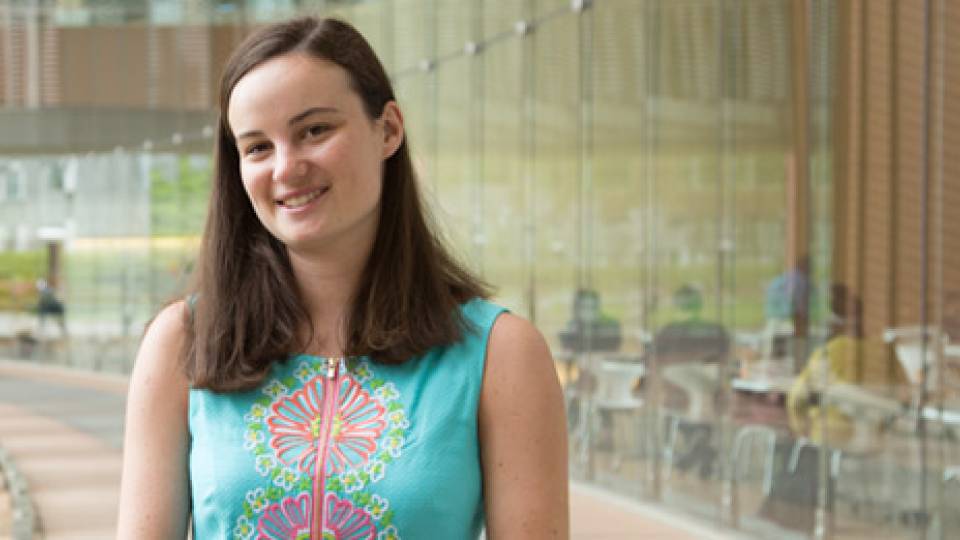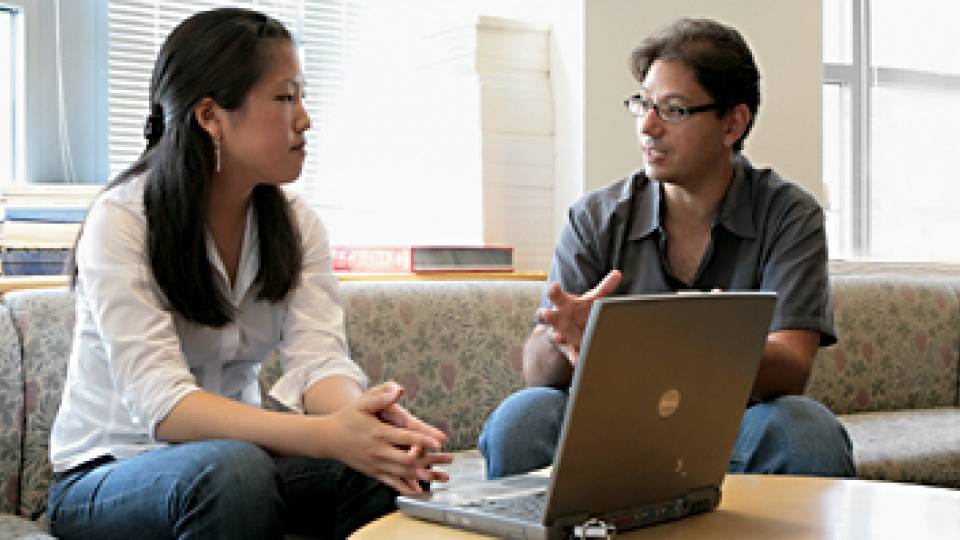Programming a robot to perform like a plate spinner at a circus, making all the tiny adjustments needed to balance a thin stick perfectly upright, is associated with what engineers call the inverted pendulum problem. For most students, the tricky balancing act can be quite a challenge. For Princeton senior Aman Sinha, it was an inspiration.
"You can push the pendulum, and it swings back as the computer compensates," he said. "It almost seems like the computer is alive."
The intricate merger of motion and reaction needed to balance the teetering pendulum brought to bear Sinha's every enthusiasm for engineering and mathematics. That desire to tackle difficult problems, to uncover the most elegant solution, has helped propel him to the top of his class. A mechanical and aerospace engineering major from Ivyland, Pa., Sinha is the valedictorian of Princeton's Class of 2013 and will give an address at the University's Commencement on Tuesday, June 4.
"The motions you go through to design the solution gave me the insight of how everything fit together," Sinha said. "It was a general approach to attacking any problem — here is how we step back and look at a problem regardless of where it came from."
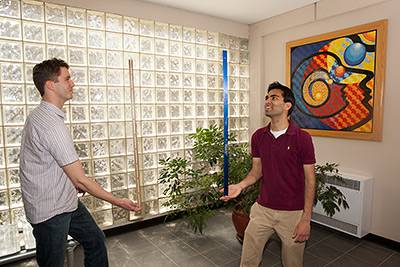
Professor of Mechanical and Aerospace Engineering Clarence Rowley, left, and Sinha demonstrate a low-tech version of the inverted pendulum experiment, a classic engineering problem that Rowley says "is like balancing a ruler on your hand." For Sinha, the "pendulum problem" challenged and inspired his passion for engineering and mathematics.
Clarence Rowley, a professor of mechanical and aerospace engineering, said that Sinha has a great ability to work through complex problems and arrive at spare, forceful solutions. Although he has moved on to more difficult work, the pendulum problem was an early example.
"It is a case where there is a fairly involved amount of math that you have to do to arrive at a solution," said Rowley. "But when you work through it, and see it actually work, it's great. It's really exciting to see it pan out. I think it really resonated with Aman."
Underlying Sinha's friendly and easygoing manner — he describes the complicated math of control systems as "really cool" — is a formidable intellect. Sinha's senior thesis adviser, Naomi Leonard, recalled that he managed to solve every problem set in her course on modern control theory on a single sheet of paper. And when it came time to present his thesis to Leonard's research group, Sinha sketched numerous equations and pictures on the board and spoke for nearly an hour — all from memory.
"The material that Aman presented on the board covered dozens of pages from his thesis work and was so carefully explained," said Leonard, the Edwin S. Wilsey Professor of Mechanical and Aerospace Engineering. "This kind of presentation without detailed notes is more typical of an accomplished graduate student."
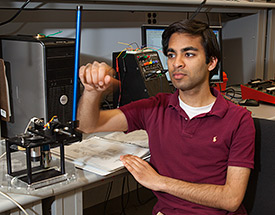
Throughout his Princeton career, Sinha has enthusiastically tackled difficult engineering problems, both in the classroom and beyond. He worked with faculty members in their labs, pursued summer internships at Merck and Microsoft, and collaborated with fellow students on design projects.
From campus to internships at Merck and Microsoft
The son of an aerospace engineer, Sinha remembers his father, Neeraj, bringing home photos of rockets and aircraft and explaining how the flow of air affected their flight. His father, who received his master's degree in mechanical and aerospace engineering from Princeton in 1982, sparked his son's interest in solving problems.
"I was always the kid who would take things apart when I was little," Sinha said with a smile.
The swirls and twists of air in his father's photos fascinated Sinha and stuck with him when he arrived at Princeton.
In the summer of his freshman year, he joined an experimental team analyzing flows in a pipe in Alexander Smits' laboratory. Smits, the Eugene Higgins Professor of Mechanical and Aerospace Engineering, called Sinha "the most promising undergraduate I have seen in my 31 years at Princeton in terms of creativity and deep physical insight."
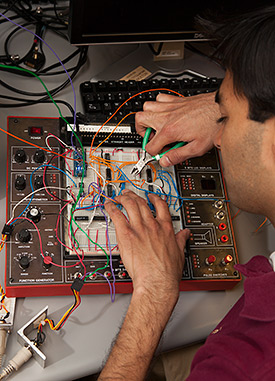
Sinha, shown here working on a circuit board, had a well-rounded Princeton experience. Adding to his academic endeavors, he served as chairman of the engineering honor society Tau Beta Pi, was a club fencer, played alto sax with the musical group Princeton Tarana, and participated in the student group Princeton Autonomous Vehicle Engineering.
Smits said that Sinha helped perform difficult analyses that linked the findings to theoretical work being performed by scientists at the California Institute of Technology. The findings were presented at a meeting of the American Physical Society and published in the scholarly journal Physics of Fluids in 2011.
"These techniques are highly sophisticated, but Aman had no trouble absorbing their complexities and implementing them with confidence," Smits said.
Sinha continued his engineering work over the next two summers during internships organized through the Office of Career Services. Between his sophomore and junior years, he wrote a program that allowed researchers at Merck to use a computer to quickly evaluate large numbers of CT scans from pre-clinical drug trials. The following year, he developed a program that allowed Microsoft's Bing search engine to identify the device a user was operating and tailor search results accordingly.
"He essentially had to get the plug-in and the service implementation finished in two weeks," said Dragos Barac, a principal development manager at Microsoft. "Aman is smart and gets things done. He picks the right solution, ensures it is pragmatic and doable, and sets about prototyping."
A 'completion machine'
At Princeton, Sinha's academic accomplishments have been impressive. In pursuing his engineering degree, as well as certificates in applied and computational mathematics and applications of computing, he received 14 A+ grades before his final semester. He won the Shapiro Prize for Academic Excellence twice as well as the George B. Wood Legacy Sophomore Prize. A member of Phi Beta Kappa, he is the recipient of the Barry M. Goldwater Scholarship and shared the Class of 1939 Princeton Scholar Award.
After graduation, Sinha will study information engineering at the University of Cambridge on a Churchill Scholarship. In 2014, he is scheduled to pursue a doctorate in electrical engineering at Stanford University on a Hertz Fellowship.
Sinha also has been a club fencer, played alto sax with the musical group Princeton Tarana and participated in the student group Princeton Autonomous Vehicle Engineering.
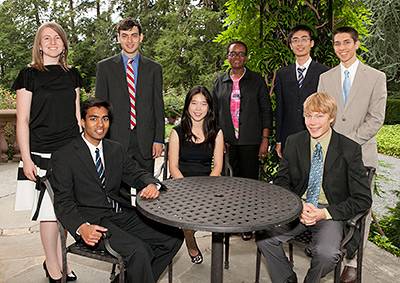
Sinha (seated at left) has received many academic honors during his time at Princeton. On the occasion of Opening Exercises in September 2011, when he was recognized with the George B. Wood Legacy Sophomore Prize, he was seated at the table with the student who was to become valedictorian of the Class of 2012, Nathaniel Fleming (seated at far right). Other undergraduates honored that day were, standing from left, Anna Patej, Jonathan Sarnoff, Tengyao Wang and Eugene Katsevich, and Irene Lo (seated). Dean of the College Valerie Smith is standing at center.
John Subosits, a senior and a friend of Sinha's since high school, has worked with him on a number of projects, most recently on the design of a high-performance aircraft called a Reno Racer. Subosits, a mechanical and aerospace engineering major who will pursue a graduate degree at Stanford next year, said Sinha is incredibly intelligent but self-effacing.
"I remember in junior year a mutual friend asked him if he was going to be valedictorian and he denied it," Subosits said. "When they announced the valedictorian, I think it came as more of a surprise to him than to me."
Last year, Sinha served as chairman of Tau Beta Pi, the engineering honor society. He also was one of the co-organizers of the Princeton Research Symposium, a student-organized event that celebrates scientific work from around the area. Another organizer, graduate student Fadi Abdeljawad, knew Sinha from a mechanical and aerospace engineering course in which Abdeljawad worked as an assistant in instruction.
"One thing that struck me when I graded the problem sets for that class was that for all 12 problem sets, Aman aced every single one of them, but still managed to write up the most detailed solutions to every problem set using only one sheet of paper," he said. "For that specific class, the average student report was roughly 15-20 pages for every problem set."
Abdeljawad said that as he juggled the tasks for organizing the symposium, he learned that Sinha, in charge of designing graphics, shirts and posters for the event, was someone who would jump in to solve a problem at any time.
"I recall working late one night and asking Aman for a modification on one of the designs. A few minutes after my email contact with him, Aman responded with 'Done' in the body of the email. I looked at the time and it was 2:45 a.m.," he said. "Since then, I started referring to Aman as 'the completion machine' whenever I saw him around campus."
Seeking 'a more intelligent way' to deal with data
A theme in Sinha's work is data. As he points out, society is flooded with so much data that it overwhelms attempts to make use of it all.
"I remember reading an article by [Google executive and Princeton alumnus] Eric Schmidt that said something along the lines of the amount of data we generate in two days is the same amount created between the dawn of civilization and 2003," Sinha said. "If we can harness the data, regardless of what we are looking at, we can be so much more efficient."
Technologists have lately coined the buzzword "big data" to refer to this flood of information and techniques for making sense of it.
Sinha plans to direct his future work at the intersection of two scientific approaches: control systems, which deal with input and feedback; and machine learning, which involves making decisions based on data. In his thesis, he examined a current system for analyzing how groups of individuals come to common decisions. Then he proposed an improvement that allows individuals in a group to adjust their decision based upon what other, trusted members of the group choose.
"Aman's ideas are very exciting, his work is highly elegant and insightful, and his results are clearly promising," Leonard said. "If he were to continue to pursue these ideas, his work would likely advance the field."
Although his thesis work is not directly related to questions of "big data," the underlying concept of how complex decisions are made drives toward the same goal.
"What I am interested in looking at is: Regardless of the environment or the application domain, what are some ways we can intelligently process or learn from data that we receive or that we generate?" Sinha said. "How do we deal with this data in a more intelligent way?"
Take medical diagnosis, for example. At first glance, Sinha noted, it seems a simple match between symptoms and disease. But as the data behind a condition becomes more and more complex, the correct answer becomes elusive.
"If I have a book on my shelf that has all the answers, everything is easy," Sinha said. "But if I have to walk into the Library of Congress, there is no way I can efficiently find an answer if my method is to look through every book starting with the letter A. Now you say, reorder all the books depending on what you think is the best."
"But what do you mean by 'the best'? That's where it gets interesting."
